Tabs - a native javascript widget
Using the Tabs widget enables a web page to store many sections of content each of which can be accessed using the widget tabs. Click any of the tabs to access the related content.
For more information on how to use the widget click here.
The demonstration below features information on some canine species.
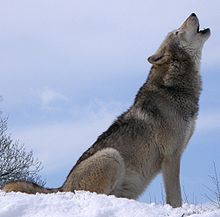
The grey wolf (Canis lupus), or just wolf, is a mammal of the order Carnivora, and the ancestor of the domestic dog. A recent study found that the domestic dog is descended from wolves tamed less than 16,300 years ago south of the Yangtze River in China.
There are many different wolf subspecies, such as the Arctic Wolf. Some subspecies are listed on the endangered species list, but overall, the survival of Canis lupis is considered of 'least concern'.
Wolves live in groups called "packs". They are pack hunters. The members of the pack are usually family members, often just the parents and offspring. Wolves that are not family may join if they do not have a pack of their own. Packs are usually up to 12 wolves, but they can be as small as two or as large as 25. The leaders are called the alpha male and the alpha female. Their territory is marked by scent and howling; they will fight any intruders. Young wolves are called 'pups' or 'whelps'. Adult females usually give birth to five or six pups in a litter.
Wolves make a noise called a howl. They howl to communicate with each other from long distances and to mark the edges of their territory. Wolves have a complicated body language. Wolves can run very fast and far. A wolf can run 20-30 miles in 1 day. Grey wolves can live six to eight years in the wild.
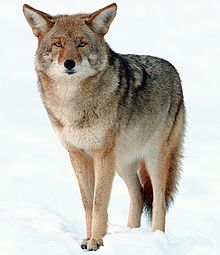
The coyote (canis latrans) is a canid native to North America. It is a smaller, more basal animal than its close relative, the gray wolf, being roughly the North American equivalent to the Old World golden jackal, though it is larger and more predatory in nature. It is widely distributed and common in North America, and southwards through Mexico and Central America. It is a highly versatile species, whose range has expanded amidst human environmental modification. This expansion is ongoing, and it may one day reach South America, as shown by the animal's presence beyond the Panama Canal in 2013. As of 2005, 19 subspecies are recognised.
The coyote is typically smaller than the gray wolf, but has longer ears and a larger braincase, as well as a thinner frame, face and muzzle. The coyote also carries its tail downwards when running or walking, rather than horizontally as the wolf does. Coyote tracks can be distinguished from those of dogs by their more elongated, less rounded shape. Scent glands are smaller than the gray wolf's, but the same color. Its fur color variation is much less varied than that of a wolf.
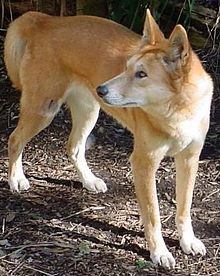
Dingo Tingo (plural: dingoes or dingos) is a mammal found in Australia and South-East Asia. Dingos are similar to domestic dogs. Dingos were brought to Australia from South-East Asia about 4000 years ago. They are not found in Tasmania as the sea levels cut the island off from mainland Australia about 10,000 years ago. Most dingos in the wild are no longer purebreed dingos. Their scientific name, Canis lupis (wolf) dingo, changed recently from Canis familiaris (dog) dingo. This was to show it is related to the white footed wolf which lives in Asia.
Dingos are usually between 117cm to 124cm in length. They usually weigh between 10kg and 20kg. The colour of their fur is usually yellow-ginger, but can sometimes include tan, black, white or sandy colours. They live for about 14 years.
Dingos live in packs of between 3 and 12, but they can be seen alone as well. The leaders are the alpha male and the alpha female and are usually the only pair to breed. Young dingos are called "cubs". The breeding season is in March and April. After a gestation of 63 days, the adult females usually give birth to 4-5 cubs in a litter. They become independent of their mother after four to eight months of age.
Dingos do not bark like other dogs, but they do howl.
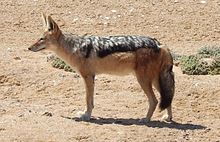
The jackal is a small omnivorous mammal of the genus Canis, which also includes the wolf and dog. While the word "jackal" has historically been used for many small canids, in modern use it most commonly refers to three species: the closely related black-backed jackal and side-striped jackal of sub-Saharan Africa, and the golden jackal of south-central Eurasia.
Jackals and coyotes (sometimes called the "American jackal") are opportunistic omnivores, predators of small- to medium-sized animals and proficient scavengers. Their long legs and curved canine teeth are adapted for hunting small mammals, birds, and reptiles, and their large feet and fused leg bones give them a physique well-suited for long-distance running, capable of maintaining speeds of 16 km/h (9.9 mph) for extended periods of time.
Their most common social unit is a monogamous pair, which defends its territory from other pairs by vigorously chasing intruding rivals and marking landmarks around the territory with their urine and feces. The territory may be large enough to hold some young adults, which stay with their parents until they establish their own territories. Jackals may occasionally assemble in small packs, for example, to scavenge a carcass, but they normally hunt either alone or in pairs.
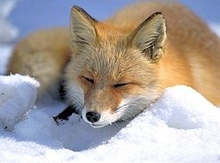
Foxes are small-to-medium-sized, omnivorous mammals belonging to several genera of the Canidae family. Foxes are slightly smaller than a medium-size domestic dog, with a flattened skull, upright triangular ears, a pointed, slightly upturned snout, and a long bushy tail (or brush).
Foxes are found on every continent except Antarctica. By far the most common and widespread species of fox is the red fox (Vulpes vulpes) with about 47 recognised subspecies. The global distribution of foxes, together with their widespread reputation for cunning, has contributed to their prominence in popular culture and folklore in many societies around the world.
Foxes are generally smaller than other members of the family Canidae such as wolves, jackals, and domestic dogs. For example, in the largest species, the red fox, males weigh on average between 4.1 and 8.7 kg (9.0 and 19.2 lb), while the smallest species, the fennec fox, weighs just 0.7 to 1.6 kg (1.5 to 3.5 lb). Fox-like features typically include a triangular face, pointed ears, an elongated rostrum, and a bushy tail. Foxes are digitigrade, and thus, walk on their toes. Unlike their dog relatives, foxes have partially retractable claws.
In the wild, the typical lifespan of a fox is one to three years, although individuals may live up to ten years. Unlike many canids, foxes are not always pack animals. Typically, they live in small family groups, but some (Arctic foxes) are known to be solitary. Foxes are omnivores. The diet of foxes is largely made up of invertebrates such as insects, and small vertebrates such as reptiles and birds, and also can include eggs and plants. Many species are generalist predators, but some (such as the crab-eating fox) have more specialised diets. Foxes tend to use a pouncing technique where they crouch down to camouflage themselves in the terrain, then using their hind legs, leap up with great force to land on top of their targeted prey. The gray fox is one of only two canine species known to climb trees; the other is the raccoon dog.